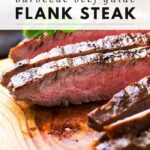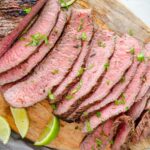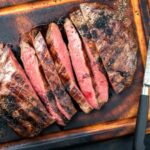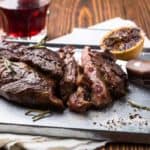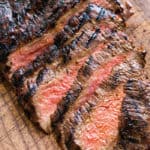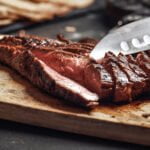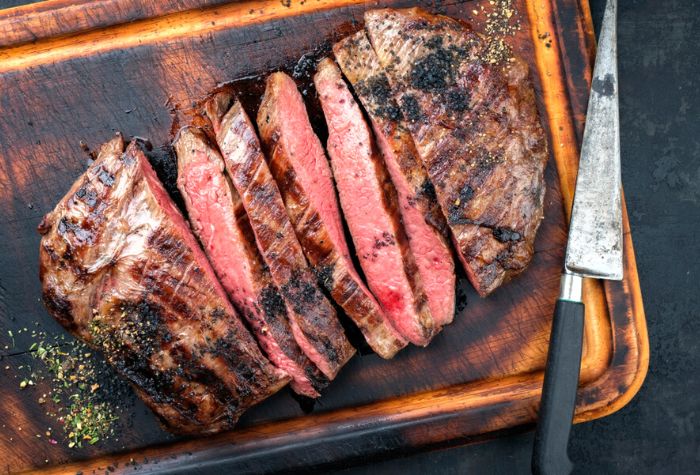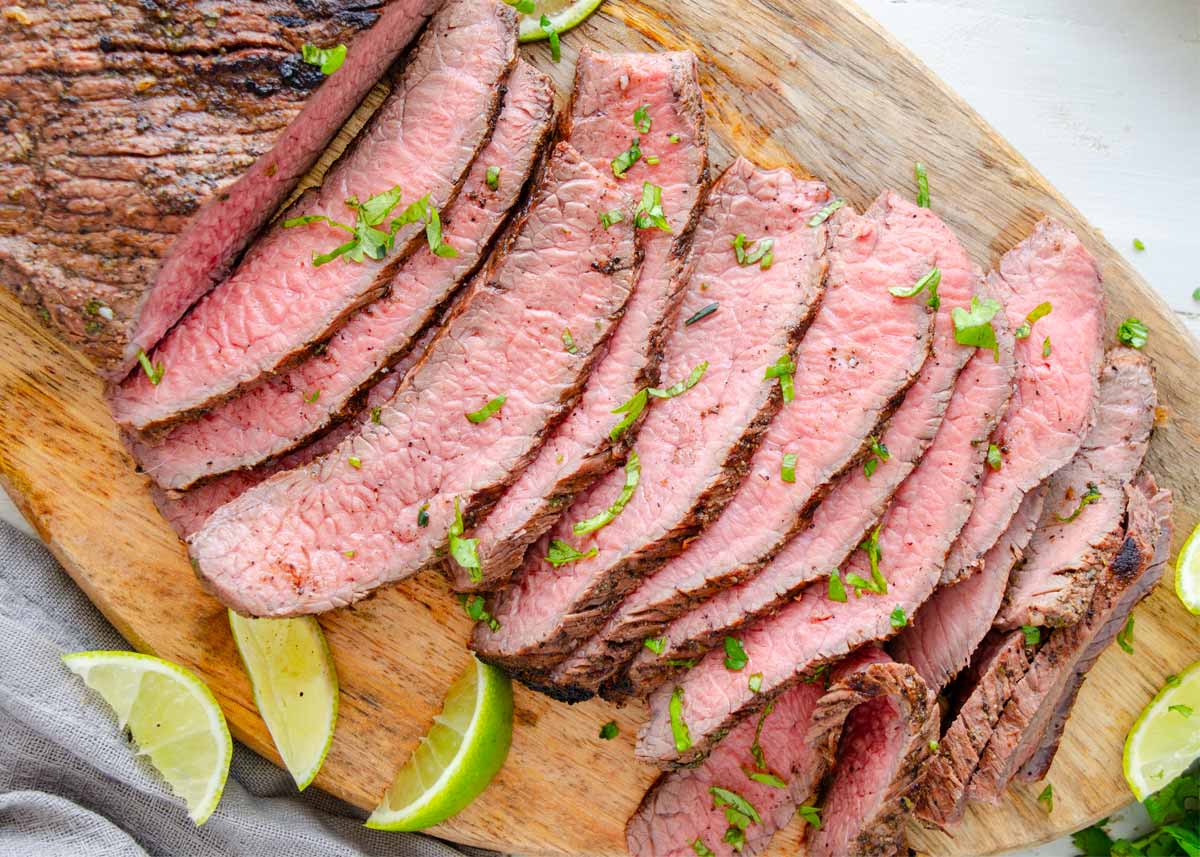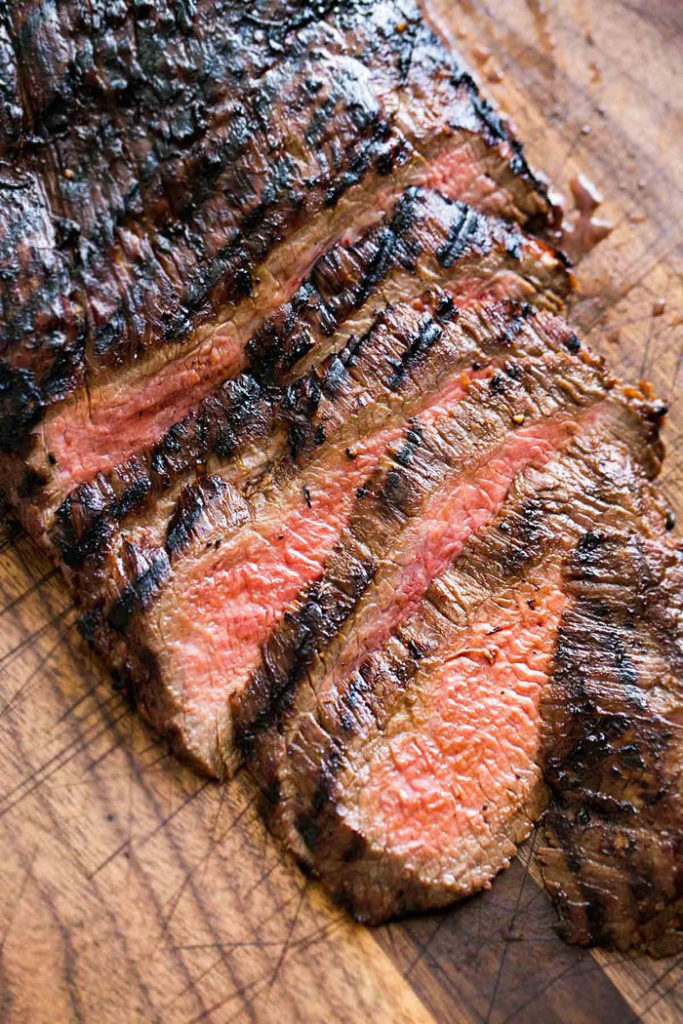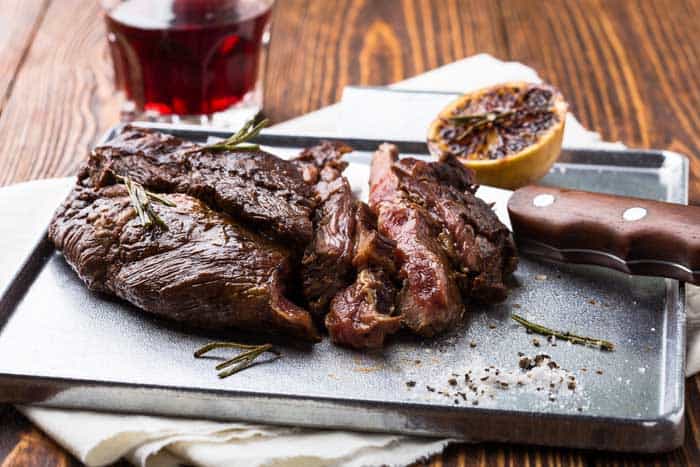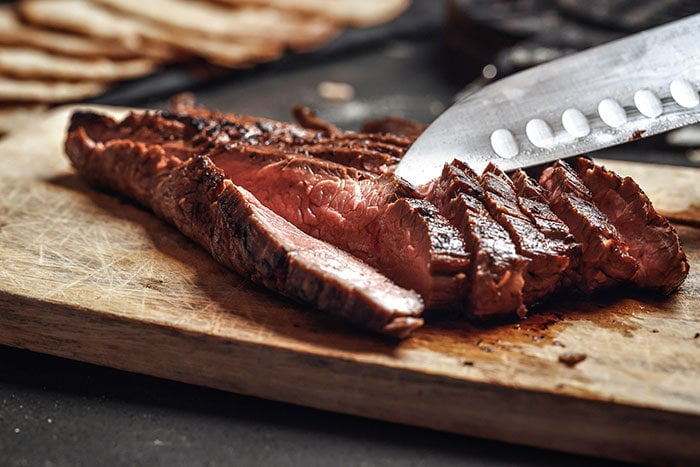Flank steak is a delicious beef cut perfect for grilling. From meat prep to cooking techniques, discover everything you need to know about this flavorful beef steak.
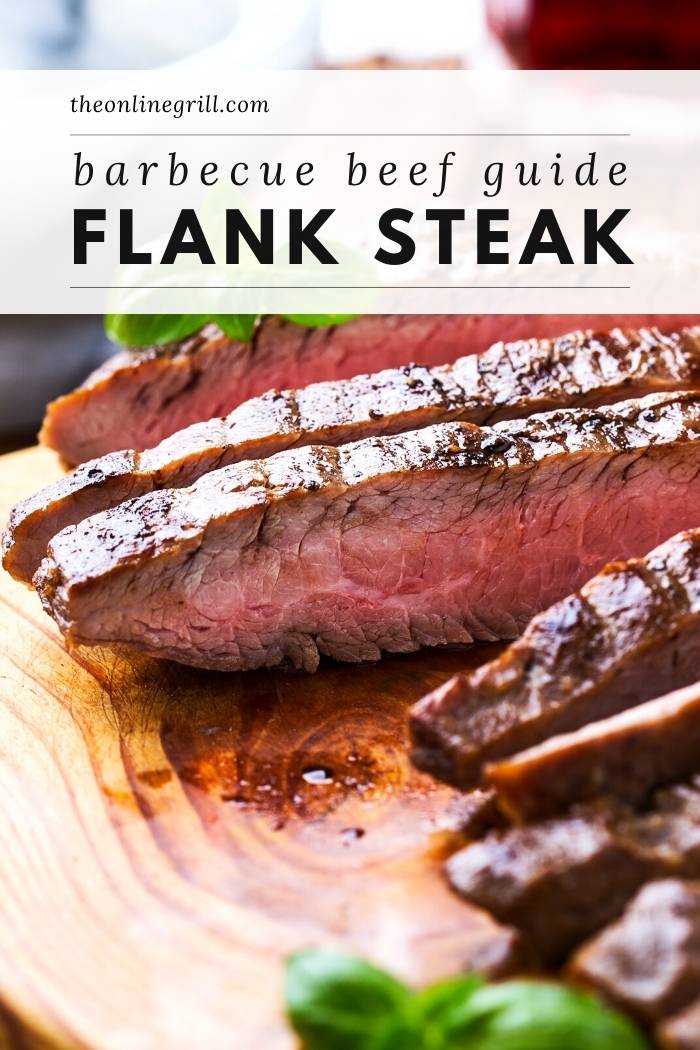
Flank steak is one of the most popular beef cuts on the market, but what exactly is flank and why do so many people buy it?
Discover all there is to know about the beef cut with our flank steak guide, including where to buy it, how to cut it, what alternatives are there, and how to grill and enjoy it.
What Is Flank Steak?
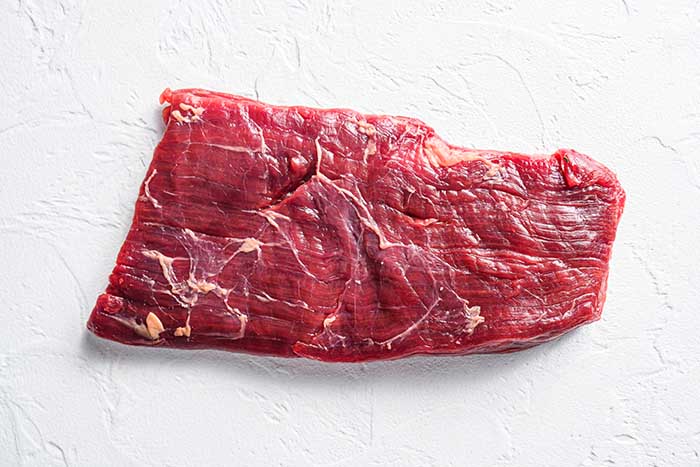
Flank steak is a tough cut of meat, usually about one inch thick and a foot long. It’s noticeably more fibrous than most other types of steak, which is why most people either marinate it to tenderize it before cooking.
This steak works well for techniques such as barbecue because it cooks best hot and fast. It’s also relatively affordable, despite its popularity, because it’s easy to cut into small pieces and use with other dishes such as fajitas and stir-frying.
Flank steak has a rich beef flavor but almost no fat, aside from a little around the edges. The fibrous muscles are far more prominent here, but proper cooking will break apart its tougher tissues and help you serve up a more tender plate of beef.
What Part of the Cow Is Flank Steak?
Flank steak comes from the dense abdominal muscles on the bottom side of a cow’s belly. A typical flank steak comes from behind the plate, before the shank and just below the short loin and bottom sirloin.
This area sees some of the most use in the cow’s body, which is why flank steak is naturally tough. Cooking methods aim to minimize toughness by tenderizing and softening the thick fibers.
How to Buy Flank Steak
Look for flank steaks that are as flat as possible. Most flanks are slightly thicker in the middle, but flatter is better. Look for dark red cuts without other dark spots or holes. Avoid cuts with brown areas, which indicate there’s been too much exposure to the air.
Good flank steaks often have a small number of connective tissues or a little fat on the end. Otherwise, you should not see much fat on the cut. Flank steak has almost no fat, so if you see too much, it was cut improperly. Look for even edges and avoid any pieces with rough areas.
Flatness matters for this cut because it determines how fast each area on the steak will cook. If only the middle of the steak touches the grill, it could cook through more quickly than the outer parts.
You can trim a little away from this steak to make it flatter if necessary. However, getting the flattest cut you can from the store is better.
How to Cut Flank Steak
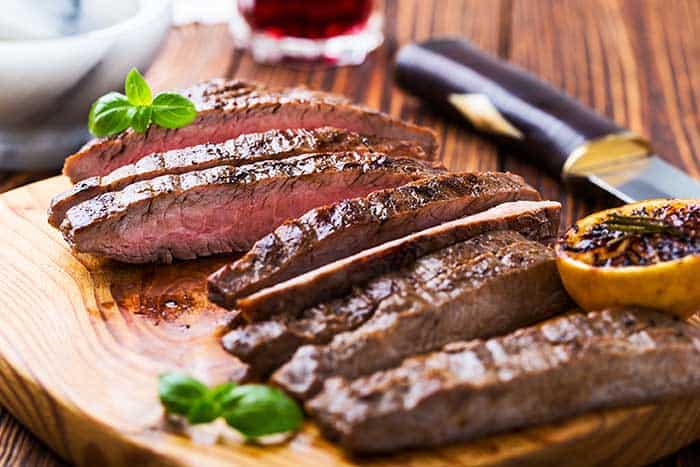
Before cooking, ensure the thin membrane has been trimmed from the steak. Sometimes, you can pull it off with your fingers. If that doesn’t work, use a knife to cut it away. Properly cut flank steak does not need further trimming.
After cooking, let it rest for 5-10 minutes. This gives the meat some time to settle and bring out its best flavor. After waiting, cut flank steak against the grain and at a 45-degree angle downward. This helps separate the fibers and makes them easy to tear apart and eat.
Never cut flank steak with the grain because that will make your steak too chewy. Slice against the grain to retain good texture and mouthfeel.
Flank Steak Substitutes
Can’t find what you’re looking for? Here are some easy flank steak alternatives to replicate that deliciously tender taste.
Skirt Steak
Skirt steak also comes from the cow’s abdomen and is fundamentally similar to flank steaks. This makes them the most popular substitute.
Beef skirt steak is long and thin, with visible muscle fibers and a row of fat along the top. It has a deep beef flavor and marinades well, making it a good choice for fajitas.
The main difference between skirt steak and flank is that skirt tends to be longer and a little thinner than flank. This means you should cook beef skirt for less time. It also has more fat, which you should trim to show most of the meat surface. Keep the deeper marbling; it will enhance the flavor of your cooking.
Skirt steaks are uncommon cuts in many areas. If you don’t see one out, ask the butcher if they have any available. This cut is often used in Mexican dishes, including fajitas and carne asada, so it’s more common in southern areas of the United States.
Hanger Steak
Hanger steak is a delicious alternative to flank steak. This cut comes from the cow’s diaphragm, an area that does minimal work. It’s easily recognizable because it has a long streak of inedible fat down the middle. Hanger steak is also one of the most tender cuts of beef, surpassed only by the tenderloin.
Hanger steak is best grilled, cooking quickly at about three minutes per side. Like flank steak, it does well when cooked to medium-rare and rested for about 10 minutes before cutting against the grain.
Hanger is one of the hardest beef steak cuts to find. Each cow only produces one of these, and most go to restaurants. It’s sometimes known as the “butcher’s cut” because butchers often keep it for themselves.
The easiest way to find a hanger steak is by ordering it from a specialty butcher. Consider calling ahead and reserving this cut, then picking it up the day you plan to use it. This cut can demand high prices at fine restaurants, but small butchers usually set reasonable prices.
Flat Iron Steak
Flat iron steak is a tender cut from the chuck, which is the shoulder area on a cow. This area features meat with a rich and meaty flavor, comparable to flank steaks. The butchering method removes internal connective tissues, leaving a well-marbled cut suitable for grilling.
Flat iron tastes best when cooked to medium-rare, like most other thin cuts. Outside of grilling, it’s suitable for broiling and pan-frying. Some people cook it by pan-searing or sous vide. Regardless of the cooking method, flat iron has a slightly chewier texture than other top cuts.
The flat iron is relatively affordable for steak, often retailing for about $10/lb. Cut this steak thin and against the grain to get the best flavor. The flat iron is more widely available in stores than skirt and hanger steaks because each cow yields several cuts.
Tri-Tip
Tri-tip steak comes from the bottom of the sirloin. Each cow only provides two tri-tips, making it moderately more common than the hanger steak. This is a relatively large, boneless cut, so it is easy to prepare.
Tri-tips normally come with more fat included. Prior to cooking, you can trim some of the skin, but for better flavor, leave some on. Remove the fatty parts after cooking.
Tri-tip takes longer to cook than the other options in this guide, requiring about eight minutes on each side for an average two-pound roast. Cut it against the grain on each side to get two large cuts, then carve each section separately to serve.
Flap Steak
What is flank steak interchangeable with? Flap steak is one of the top contenders for this position, serving as an excellent replacement for flank steak in most recipes.
Depending on your location, these steaks come from the bottom sirloin area and might also be known as sirloin tips. It’s often cut into cubes or long strips, but you can ask butchers for the whole steak.
Like most coarse steaks, flap steak works well at holding flavors from marinades. It has a rich beef flavor, so you might not need anything beyond salt and pepper. Try cooking this meat to just less than 140 degrees, as it has more flavor closer to medium than rare.
How to Grill Flank Steak
What is flank steak if not for grilling? Preparing this cut to grill is relatively simple.
For a regular grill, preheat it to high and add some oil to the grates. This will help stop the cut from sticking to the grill. Most grills have their high setting set to around 450°F (230°C).
Cook the steak for 3-5 minutes on each side. The interior should be 130-135°F (54-57°C) to cook it to medium-rare. A temp of 125°F (51°C) isn’t hot enough and 140°F (60°C) is too much. It might take some experimentation to determine exactly how long to cook a flank steak on your grill.
Ways to Enjoy
There are many ways to enjoy a flank steak. Most people marinate the steak for several hours before grilling. This can impart a lot of added flavor while helping tenderize this tough cut before cooking. The rich connective tissue in the beef also makes smoked flank steak a great way to achieve tender, flavorful barbecue meat.
Reverse searing flank steak involves smoking it at low temperatures before searing it on the grill, which is the reverse of the normal method. Reverse searing is effective for flank steak because it offers additional control over the internal temperature.
Flank steaks are also a popular cut for fajitas, which typically include other grilled ingredients inside a tortilla.
If thinly cut, flank steak can also be used for a steak sandwich. Choosing bread with a similar toughness can provide a more consistent experience when eating flank steak this way.
